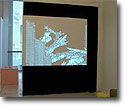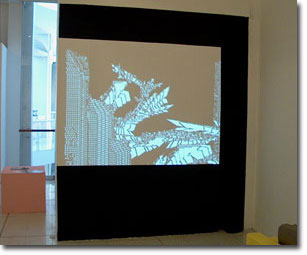Centro Cultural Olimpo,
Jul 16, 2005 - Jul 25, 2005
Mérida, Yucatan, Mexico
The biennale InteractivA 05
by Eduardo Navas
Invited curator Lucrezia Cippitelli (Italy) in her first screening presented a series of experimental videos from various artists in Italy, which can be downloaded from the web. The videos ranged from playful to heavy social commentary. Some questions she brought up were on virtual spaces versus real spaces, do people who make videos have real spaces? And how is the web changing the idea of a space in relation to video? She also presented the work of Otolab during a special screening. This work consisted of software used by Djs and VJs that created visuals meant to be experienced along with music in a very specific settting of a dark room with four walls, which was, unfortunately not available at InteractivA, so an image of overlapped animations was projected on a single wall. The work consisted of abstract red and orange shapes that developed on the fly reacting to the sound that played along during the presentation. She also curated in one of the galleries an installation of a set of abstract videos following the aesthetic of software art, which in this case created images that appear to be random shapes, but structured with specific algorithms; they were presented in DVD format, which made the viewer wonder how a linear narrative can appropriate the aesthetics of digital media. Cippitelli, by presenting works in these different contexts, asks the viewer to reconsider how time-based media is understood differently as a gallery installation, as part of a screening, or as downloadable files available on the Internet.
Maria Benjamin and Ruth Höflich from Guestroom explained how they go about developing an alternative publication in the U.K. Guestroom is an artist run journal that considers the idea of publishing as a form of exhibition. Each contributor is given free reign to decide how to present their material. It is important for them that this activity works independently of the current gallery system. Guestroom takes advantage of emerging technologies to make each print issue challenging not only in the process of publication but also in terms of creating alternative spaces to reflect upon works of art.
Raquel Herrera Ferrer presented her book Tempus Fugit, which considers narratives created with new technologies. She chose a set of artists who are not necessarily part of the usual art circles but whose work she found quite relevant for her arguments. Her writing was influenced by Baudrillard as well as Umberto Eco, and Janet Murray. Some of the questions which drove her research include, what is interactivity? What is it for? What is the relationship between media and space, and navigational space in new media?
Heidi Figueroa presented on how cell-phones are affecting the way people understand their physical space in Puerto Rico. Notions of being here or being there become complex when people are able to use technology that apparently brings them closer, but which makes them more dependent on highly developed devices to constantly feel in touch with others. Developing a dependency and even a fetish on such devices were some of the aspects of this social phenomenon that she was critical of.
Susan Lord and Janine Marchessault presented on Translocality and art. Their research currently focuses on how artists are using new technologies to communicate across localities and how new technology is being used to create exhibitions in different spaces online and offline. A series of case studies are being gathered, many of which focus on works around globalization and the role of the Internet to bring about change.
Fuss, a collective based in Germany and Spain, was represented by Timo Daum. He presented "Ambientador" an interface created in Macromedia Flash, which allows the user to create music and graphics on the fly. "Ambientador" consists of a radar like interface where the user drops selections in the form of small dots. When the radar needle come across the dots, sounds and graphics are emitted. The user can keep adding or deleting material as she/he desires. During the presentation, the graphics that were combined according to the sound selections were meant to be seen on a separate screen, unfortunately due to the limitations of InteractivA, the work was presented in one screen. The work can be used in different contexts including raves or more experimental events.
And it is also available online for download.
Zedik Arte Joven (Mexico) performed sonoric poetry. They are a group of young performers who created soundscapes with their voices, and bodies. They interacted with the audience sometimes instructing them to clap or make abstract sounds on the verge of creating words. The concept was to develop new forms of meaning that become open-ended as the audience struggles to understand a possible narrative.
|









